
This month we follow our Creative Director Dudley and the team on their visit to EuroShop 2023.
Some of you may have already seen these highlights, but if you haven’t – Click here to see how a new take on existing technologies can engage, excite, and activate the imagination of shoppers.
This year the themes of discovery, play, intrigue, and user creation really energised our team. Meanwhile, the theme of sustainability remaining high up on the agenda ensured they were left reassured that important issues weren’t being ignored.
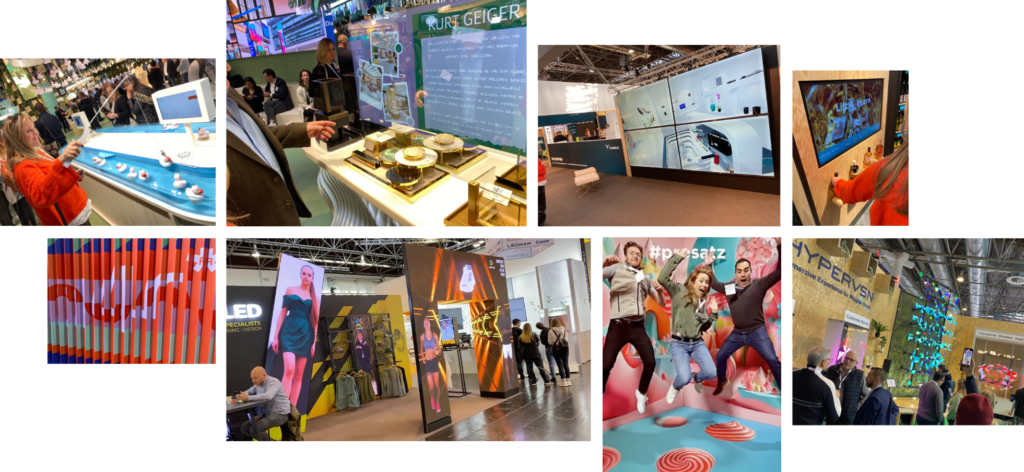
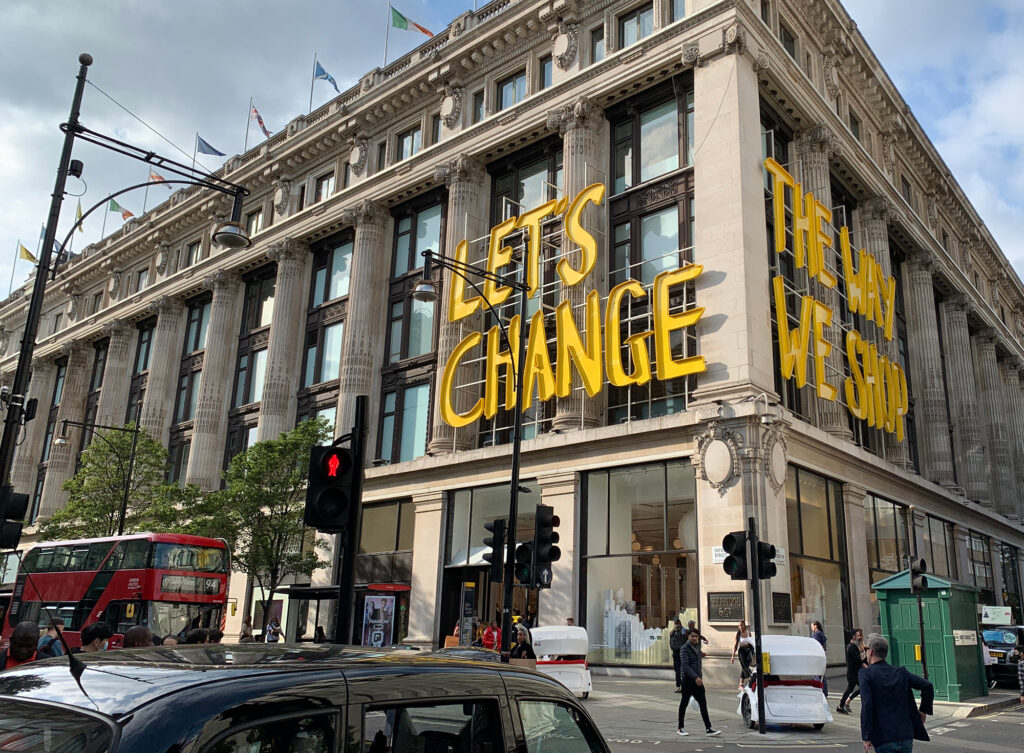
There is no doubt that consumer behaviour has had a shift in the last 5 years. This shift has seen consumers making informed choices about products based on green credentials and dropping brands that aren’t legitimate in this space, whilst embracing and explicitly promoting those that are.
Perhaps spurred on by the obvious changing patterns to our weather, or the swaths of plastic floating in the pacific, or pollution crisis after pollution crisis, whatever it may be – 70% of individuals across 30 countries believe they will be failing future generations if they don’t look to fight climate change through better product choices and recycling [1]. That said, they don’t believe the onus is on them alone – 51% of people think the primary responsibility for more ethical and sustainable consumerism lies with businesses [2].
Sustainability measures consumers expect from retailers include: Recycling, used & refurbished clothing sections, alternative packaging, refill options, the elimination of single use plastics, the ability to hire, or food waste solutions, to name but a few.

This ‘green awakening’ is set to continue, and since it can be so ultimately beneficial for all involved to be more sustainable, then brands and organisations of all kinds should get onboard and push the agenda.
Below are just a few of the key questions we asked Lynda our Strategic Development Director and Dudley our Creative Director in a recent interview about Displayplans’ Global Sustainability drive:
How much demand are Displayplan getting from clients for sustainable solutions?
Lynda: Global brand clients are asking to understand the carbon footprint and environmental impact of displays. Additionally, they want to understand the total impact of their operations, therefore they’re asking us to account for the carbon footprint of our operations as well.
For many of our UK retailer clients, sustainability conversations about equipment and retail fit out solutions does not get as much attention as their priority, the products themselves. Though there is a lot of curiosity and open mindedness, and each month we are having more and more sustainability conversations. Which is encouraging, it’s what we want.
Dudley: The competitive edge that can be achieved making sustainability an overt focus can’t be ignored, what’s great is that much of what we deliver is sustainable. There is still a real balance to be found between desire and costs; while clients come to us with a desire to be more sustainable, they also have procurement departments looking to reduce costs which we cater to through value engineering. We work to continually improve and refine and support our clients.
How do Displayplan cater to that demand?
Lynda: Our concept and tech design teams always keep a few core principles in mind:
- Use recyclable materials only, for example – no PVC
- Design for disassembly, no bonded materials, everything must come apart at the end of life to go into separate recycling streams.
- Always utilise 100% recyclable packaging
We have a great process for tackling sustainability-specific requests related to measuring the carbon footprint of existing equipment, and then as Dudley mentioned, we value-engineer alternative approaches to then reduce the carbon footprint.
Dudley: The crucial starting point is asking the right questions up front to make sure we understand the client’s needs. It’s then our job to educate on practical applications and continue to propose impactful and exciting retail experiences that meet the above criteria Lynda listed. As well as push the agenda to be as sustainable as possible using Circular Economy principles.
Being part of the wider conversation is crucial too: We’re part of the POPAI Sustainability Council, which leads sustainable approaches and tackles industry issues. We actively get involved in debates and look for ways to solve and educate all stakeholders. Constantly learning and keeping our finger on the pulse of what’s happening in the industry means we can ultimately be more helpful to clients too.
Specific to sustainability, what services do Displayplan offer?
Dudley: It’s our aim to be the best partner in our industry for sustainability efforts. We’ve had our Measure, Reduce, Offset approach in place for the last three years.
We look to align to clients’ specific strategic objectives and support with specific tools to foster progress. Tools such as sustainability workshops, using LIST analysis to establish carbon footprint, Value Engineering, and we use Gold Standard for offsetting.
Is there a client that is forging ahead with a sustainable retail offering?
Lynda: I would say Nike and Adidas are on point to meet consumer demands. Both have exciting footwear and apparel options made from recycled shoes and/or ocean plastics. Often these are then supported with in-store merchandising and fixtures made from the same materials.
From an FMCG perspective Mars is firmly focussed on sustainability, their product ingredient supply chain takes priority, but they are working to streamline displays, make them lighter, smaller to ship and easier to refurbish or recycle. This may not be obvious to the consumer yet, but lots is happening behind the scenes.
Dudley: M&S have been at the front of sustainable approaches to retail fixtures and stores. We wrote the Sustainable Designers Guide in collaboration with them. This is used to set an expectation and is shared with every design agency, supplier and company they work with for store design. It sets the standard for sustainable design. We wrote the rules that we all work to.
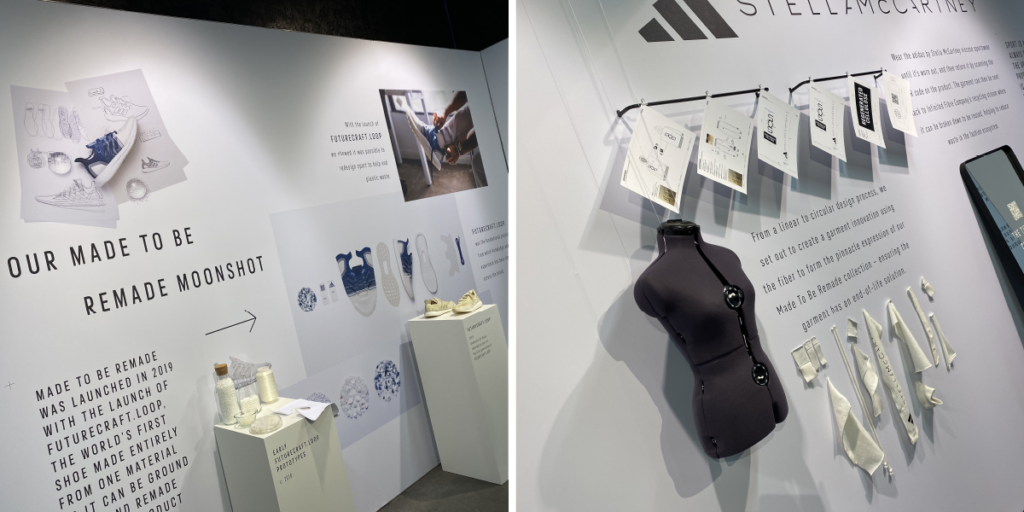
Is there one lasting thought you’d like to leave with people reading this?
Dudley: We are extremely passionate about this topic, to us it isn’t just a business solution to provide a competitive edge: We aim to be sustainable and carbon neutral as an organisation, because we care, and we believe that collectively we have a moral obligation.
Lynda: What is needed is constructive open-mindedness, along with realistic expectations about what larger organisations will accept for an end result, cost, and overall value. In the future, the kit we provide will directly cater to shopper needs. From the endcaps that will dispense bulk products into re-usable containers, to modular display systems that are refurbished and re-used in stores for multiple cycles. Now is the time for us to re-write old rules in the retail business, making sure we are transparent, to make long term effective change.
The team have plenty more to say about sustainability. To hear about what brands Displayplan find inspiring, or for more snippets of this interview, keep your eyes peeled on future newsletters and our social media pages.
Thanks for reading.
[2] IPSOS MORI Feb 2022
At first the concept of insight driven design seems like a no brainer, if you’re not designing with the driving force of insight, then what are you designing to?
The truth is there are many ‘drivers’ for design, from wider macro factors such as technological advancements, or trends towards sustainability, to more detailed micro factors such as budget or clients’ requirements or interests.
And of course, what we value individually and as a company, and what our clients value plays into what we design. However, the uniting factor is and always should be meeting the needs and desires of the shopper.
Frombrief all the way to concept and build, our account team, strategists, and designers, draw on their years of experience to cater to the needs/desires of shoppers through true insight. Taking a human-centric end user (shopper) approach to innovative in-store design.
It’s easy to confuse insights and facts, however, so what is insight?Insight is not as simple as “women wear makeup”, it’s about finding a crucial tension within the information to unlock growth, and opportunities to connect to an audience. That said, when an insight is uncovered and understood, there should be an ‘of course’ simplicity to it. Its at this point one knows it rings true.
For us, being insight driven is about using an in depth understanding of 3 of the 5P’s – People, Place and Promotion to deliver objectives. Rather than being reactive and meeting our clients briefs to deliver tactical responses across those elements of the marketing mix, the earlier we get involved with the marketing process, the more fruitful the result has proved to be.
When our clients share detailed Demographic, Geographic and Psychographic knowledge of their audiences, we are able to use the lens of shopper understanding to find the ‘silver bullet’ which enables us to deliver effective and impactful in-store solutions. Where this isn’t possible and our clients are looking to us to uncover insight, we’re able to apply generic shopper insight, and detailed understanding of their product, business, and market to develop meaningful insights for use. In the following examples you will see instances where we had a more prescriptive and more open brief from our clients.
Garmin MID system
A celebrated and respected brand with a strong following amongst both amateur and pro sports audiences. These are people who already know they want a Garmin watch however they perceive Garmin to be a complex family of products which hinders the purchase process.
Visibility (to attract) and accessibility (to engage) were key in this in-store solution that was created for Swedish Stadium sports stores. Shoppers needed an area where they could browse easily. Somewhere they could interact with the product, learn, and be aided in their purchase choice.
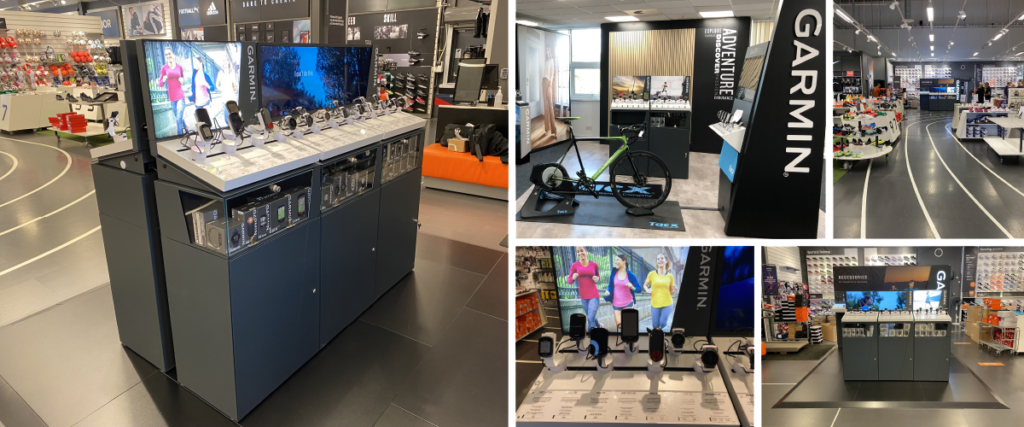
Insight
“I want to browse in-store and learn but I don’t want to be bombarded by salespeople or overwhelmed with intricate information.”
Solution
A modular display system in which 8 core displays are made from 15 key components.
Result
Retailers benefitted from increased sales. For example, store with smart screens, plus lift and learn features in Sweden sold more products. POPAI Sports and Fashion Gold Award Winner.
Braun: Pop-up shops
Braun is a well-known, well-loved brand, popular with audiences who are well aware of the products they offer. However, category wide, foot traffic to traditional department store has dropped in recent years and shoppers are turning to online or electronics specialists.
Subsequently when shoppers seek out electronics, they have standardised, full category engagement rather than a specific brand experience which can be complicated and overwhelming.
We were tasked with finding ways to attract shoppers to physical retail locations instead of ordering online. Blending physical, digital and shopper behaviour to give a compelling reason and reward to visit physical stores.
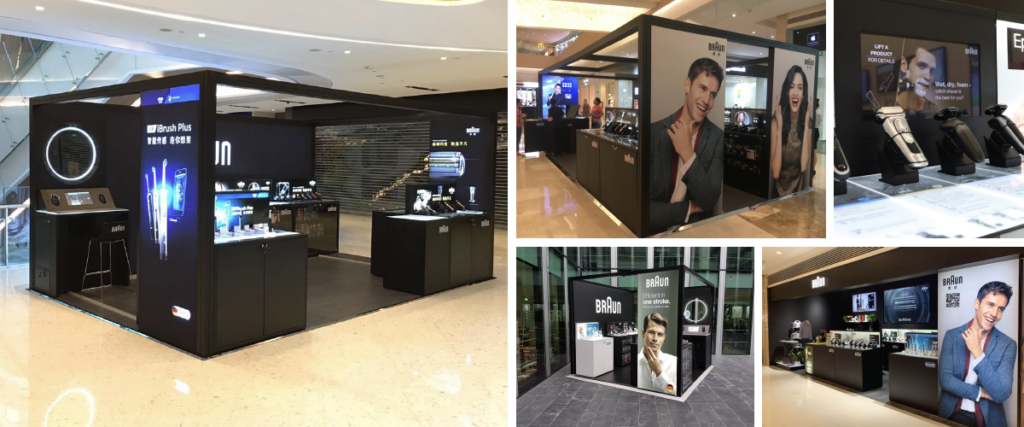
Insight
“I like Braun products, I’m fairly well-informed about the range, everything I need is available online and often at better prices and I see no real need to go into a store to buy.”
Solution
To reconnect to audiences. Using relevant integrated technology, create real experiences that connect to a wide set of audiences. Give shoppers a reason for visiting a store, through a tangible benefit:
- Cash Back (X% discounted purchase price or rebate)
- Warranty Extension (+X years on top of base manufacturer warranty)
- Satisfaction Guarantee (100 days satisfied or money back)
Shoppers are encouraged to share their email and personal details for these reward or experiences only available in-store.
Modular systems scalable and adaptable to any footprint. Using relevant technology to appeal to the wide demographic was key. This included welcome and large format attract screens, QR for engagement through Mobile phones, freestanding interactive kiosks, magic mirror technology, play-tables and in-aisle lift and learn; all used to provide personal messages, easy in-store navigation, easy product range browsing, education, comparison and guidance. These solutions were designed to create visibility for shoppers, to inspire storytelling, and prompting social media sharing and conversation.
Placing brand experience pop-ups in high-traffic mall and shopping centre locations, drives footfall and captivates new shoppers.
Result
Pop-up shops outperformed shop in shop installations in nearby department stores with greater sales. Subsequently the pop-up solution won the POPAI Pop-up Shops Silver Award.
Craig & Rose
We were tasked with creating an immersive in-store experience that introduces urban Glasgow artisan shoppers to Craig & Roses’ latest product ranges, bringing the boldness, individuality, and progressiveness of the brand to life!
Craig & Rose needed to separate themselves from other retailers in the area, and to ensure clarity about their prestigious offering. This was an opportunity to break out from existing store formats to create a more unique, bold, and creative space.

Insight
“I love shopping locally in Glasgow but none of the high street shops I see satisfy my artistic side with design appeal.”
Solution
Appealing to the local Glasgow artisan audience with a dynamic kinetic sculpture, using latest paint colour range, combined with an inspiration table to create a focal point in-store. This all draws foot traffic inside from the street for one-on-one consultations and engagement. A cosy aesthetic achieved with a dark colour palette, inspired by local architecture, highlighted the high-end design appeal of this brand within a new unique bold format.
Result
A space that draws consumers into a unique brand and product experience that gives a satisfying reason to visit the store. Elements of this bold solution are being filtered into mainstream store test and trial formats.
In summary, insights incorporate multiple lenses but must be singular, concise, and clear.
Hard sales data, business goals, client KPI’s, quantitative research all factor into insight creation & solutions provided, nevertheless it’s the softer quantitative audience research, to understand the why and to uncover that crucial tension, that unlocks growth. Digging deep to understand the end user or shopper and putting their desires at the centre of the solution better is crucial to creating effective in-store solutions.
If you are interested to know more about any of our case studies, or to speak to one of our team members. Get in touch via our contacts page. We’d love to hear from you.
Shop-in-shop or ‘retail concessions’ are not a new concept. It was department stores that kicked off the business model a staggering 150 years ago thanks to an inspired Parisian called Aristide Boucicaut.
In the last few years though, we’ve seen the closures of department stores worldwide and a shift to seeing concessions in new and sometimes surprising places. In hindsight though, where we’re seeing these new concessions and what those concessions are – make absolute sense.
It’s been a number of years that we’ve had Costa coffee shops in Tesco stores and M&S stores, Habitat in Sainsbury’s, and Starbucks in several retailers including Amazon Go stores. The latest that consumers might delight in is Holland & Barratt and The Entertainer toys in Tesco stores, Paperchase in Next stores, or more notably ‘Garden by Homebase’ in select Next stores. (Side note, Next’s retail business strategy is captivating, and we’ll be writing about this in the coming months)
Across the pond, brick-and-mortar Toys “R” Us stores are back, with Macy’s announcing the opening of stores in 9 US states, with another due to open in a further 19 states before the holiday 2022 shopping season.
There is a lot of change afoot, and whatever each parent retailer’s shop-in-shop’ strategy, one can only assume that the relevant departments are due to have a busy few years ahead. It seems every day there’s something new to digest in this space.
So, what is happening?
The most obvious place to start is the pandemic. Significant shifts happened during this time and digital progress took great leaps forward: Online purchasing skyrocketed with PWC reporting that 16% of consumers now say they intend to purchase more online (1), and people were suddenly accepting of online education, concerts, and socialising.
Although online sales have jumped the previous trajectory of online shopping, there is still a need for a physical destination. Having a destination offers advantages that online shopping cannot: In person expertise from staff, product sampling, brand immersion, and a sense of community.
According to Trendwatching bricks and mortar retail will still have a firm place in consumers’ thoughts and behaviour as they look to reclaim their local and maintain a State of place. 53% of people polled were more interested in shopping locally than before the pandemic (2). And ‘near me’ shopping searches remain popular. Additionally, they say brands that look to make those ‘local’ spaces better will hold a particular affection in the minds of consumers.
Responding to these shifting behaviours, supermarkets and retailers like Next have searched for ways to re-establish the pull of the destination, enhancing the in-store shopping experience for customers, and encouraging dwell time.
As we now face more economic uncertainty, consumer behaviour is set to take another dramatic shift. Particularly in the UK, we can expect to see people cutting back on spending, trading down, and shopping around for better deals. This lack of loyalty will naturally affect both brands and retailers. Therefore, placing oneself firmly on the destination map and placing consumers at the heart of the retail offering, and catering to their needs has never been more important.
So how do you maintain your brand essence when you’re in someone else’s space?
Besides the destination, the intricacies of concessions are unlikely to have changed much. However, this is a relatively new play for some parent stores, and for the brands, this is a new partner also. Although this is a win-win for both parties, as with any new joint venture there are intricacies that will need close monitoring. Particularly when it comes to maintaining your brand essence in what may be a complex space.
To ensure the brand essence of both parties is upheld and respected, solutions for providing great brand experiences within parent shops are as dynamic as one would expect. Finding a display partner who is capable of supporting the shop-in-shop relationship and its intricacies is vital. At Displayplan we believe that flexibility, a detailed understanding of both parent and concession shops, scalable end-to-end solution focus, and a deep understanding of consumers, are the backbone of any good shop-in-shop relationship.
Let us talk you through a couple of examples:
Braun Lighthouse Boutique Media World, Rotterdam

Braun products are sold in a variety of different parent stores, from pharmacists to electronics specialists. Creating brand destinations and helping shoppers engage with the full Braun range completely separate from any influence from the wider category is key. In this Braun ‘lighthouse boutique’ at Media World (MediaMarkt) in Rotterdam post build 100% of Braun and Oral B products were demo-ready and shoppable where previously only 50% of the range was on the shelf.
As with all retail builds, the parent stores’ requirements and store layout must be respected, and this can sometimes mean thinking outside the box and working within a physical environment that is not traditionally considered ‘on brand’ for Braun. Here we designed the perfect blend of brand and product experience with product stock instantly available thanks to clever hidden storage.
Drawing on years of experience in understanding both the brand and the parent store ensures we have the ability to provide the design vision as well as deliver an engaging, and impactful digitally supported interactive experience. With this new design, a sales associate was given a discreet partition to work within and was therefore available to provide shopper assistance with comparison and selection. With this particular case our client was delighted with their sales uplift goals.
Garmin concession, Stadium, Malmo, Sweden

We work with Garmin market teams across Europe to deliver Garmin retail experiences that are inside different types of sport retailers from generalists to specialists like bicycle stores.
Placing Garmin inside a parent store we have to understand the retailer’s brand and physical requirements, as well as local health and safety regulations. We create a complete design layout for approval by both Garmin and the retailer, ensuring the right hierarchy of messaging is complete, and products are presented in a way that best allows shoppers to test and trial the Garmin products in that store.
Stadium stores in Sweden are all unique in size and floor space, and the placement of Garmin’s concession was often unknown. Therefore, a number of aspects were critical to success: displays needed to be modular and fit within the slat wall systems of Stadium stores, they needed to be flexible enough to fit wherever they were positioned. Equally displays needed to be eye-catching and incorporate digital elements, accessory-specific zones were needed, and lastly, consumers needed to walk away with absolute clarity on how these products could potentially impact their sporting life. As always Garmin’s product needed to be the hero, and the space needed to be owned in a very Garmin specific way.
In conclusion
Overall, the new breed of parent stores we are seeing is a win-win for brands and retailers alike. Partnering with recognisable brands and retailers gives parent retailers benefits not only from rented out floor space, but also offers a new way to engage with potentially a different audience.
The concession of course benefits from a captive audience and increased footfall placing their product in front of potentially a greater audience than they might find on the high street.
As ever though, it’s the consumers’ needs that should be at the heart of what both the parent shop and concession does. According to Simon Quirk of Kantar – “the key to a good concession strategy is to really understand your shopper demographic and the nuances of your local catchment area – who is coming through your doors, what are their spending priorities and where else do they regularly shop”
Whatever it is consumers are looking for it is our job to provide this for them, so paying close attention to not only accelerating consumer trends but also keeping an eye on wider macro factors will prepare us for the next event; be that a financial downturn, supply chain issues or another pandemic.
(1) Where next for retail – Strategy&, PWC
(2) Trendwatching report 2022
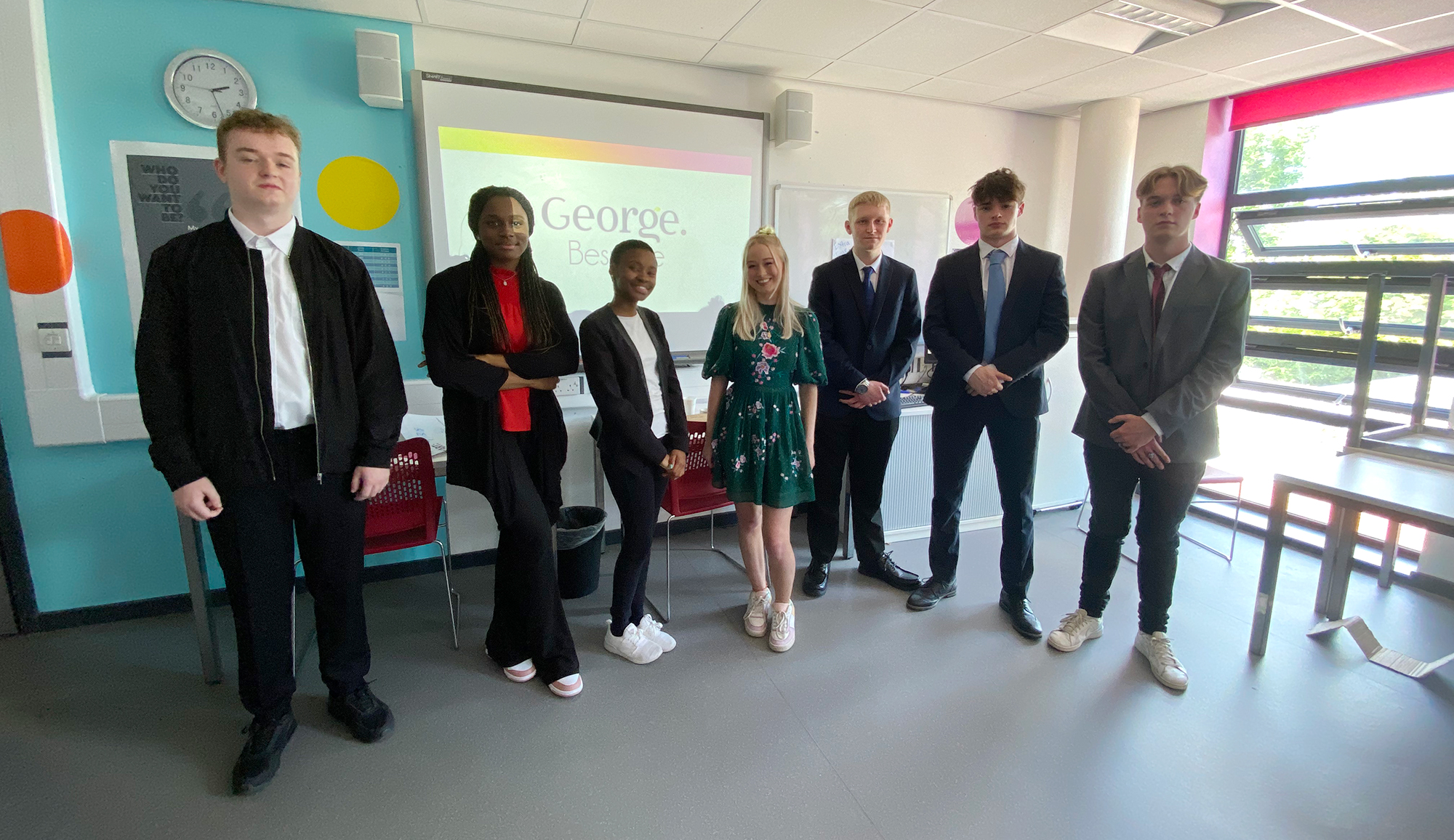
Earlier this summer we were fortunate enough to be approached by North Herts College to get involved with a work experience project for 2nd-year students studying Business.
Working with the community has long been something we are passionate about at Displayplan. So, alongside our yearly community charity work for Mind Hertfordshire & Headway Hertfordshire we knew we wanted to do more to engage with people beyond work and the business world. So, when presented with the opportunity to provide a team-based work experience for college students and connect with inspiring young minds, we jumped at it.
While evolving technologies and platforms that create digital encounters continue to reshape the way we connect with each other, nothing beats face-to-face connection. In our day-to-day work we look to create engaging & meaningful connections between shoppers and retail, so what better way to engage with our own local community than by meeting them, talking to them, and working with them on a fun project?
After talking to the students about what we do at Displayplan, who our clients are and more generally about retail experiences with a big picture view, the students went on to discuss their own retail experiences; what they see, what they enjoy and how they shop.
We then put our challenge forward.
Using the work activities we had laid out, and the key service areas of our business: Insight & Strategy, Design & Development, Digital Innovation, Global Supply, Programme Management and Sustainability. We asked them to come up with a retail experience that they personally would find appealing, applying these workstreams to their choice of client.
Team 1 had a great idea to create a digital display in ASDA with a system of icons and templates that enabled shoppers to personalise apparel. Following the purchase of the design through the display, it would then be printed in-store, allowing shoppers to walk out that same visit with a completely custom piece. What we loved about this was the inherent benefit of increased footfall and drawing younger shoppers into stores, a consideration that is often put forward by our supermarket clients.
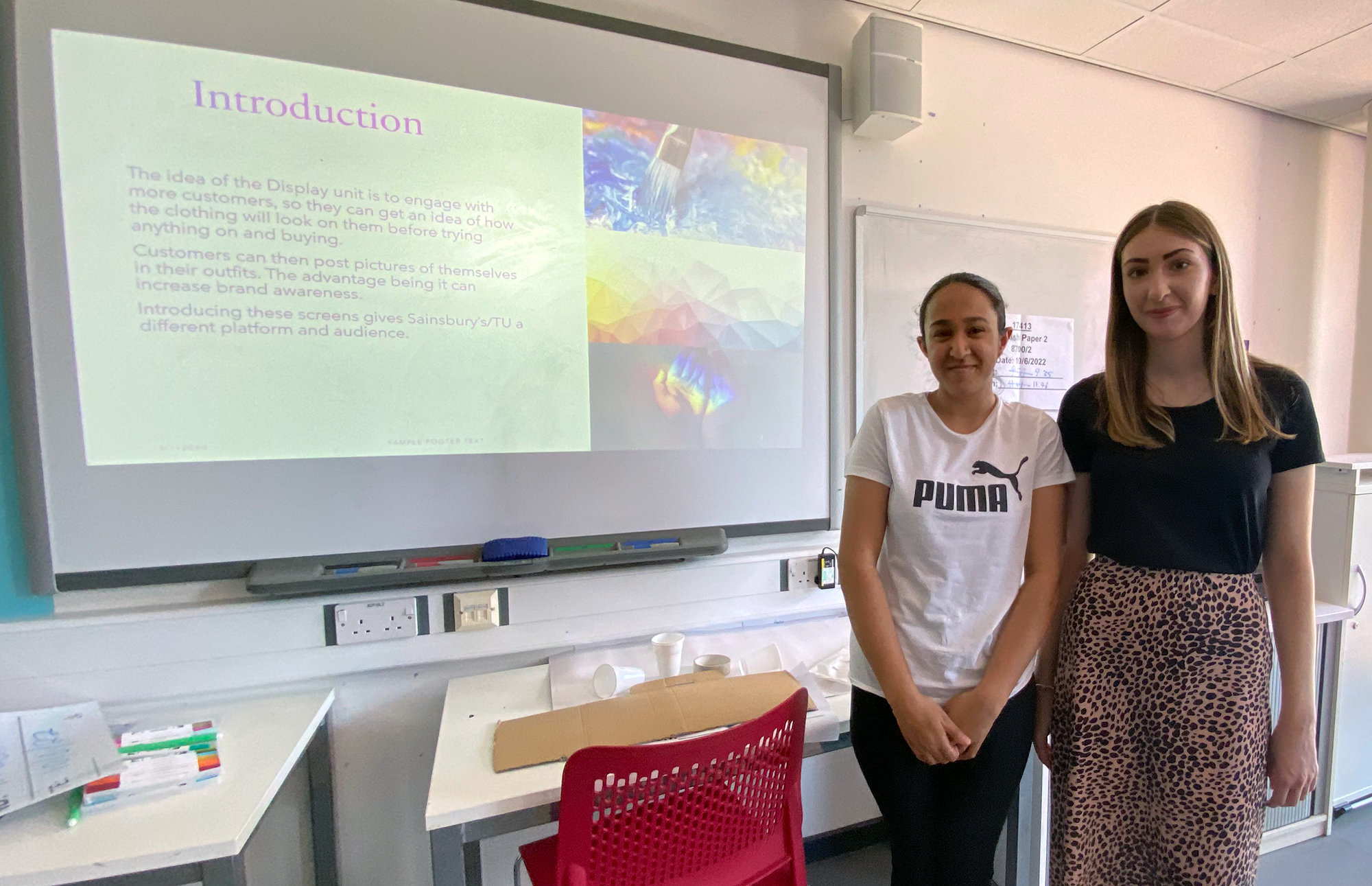
Team 2 was equally notable, with the concept of a Sainsbury’s TU digital display that allowed shoppers to review an AR image of themselves wearing their chosen outfit in large format in-store, and share on social media before purchase. Introducing these screens would give Sainsbury’s a different platform both in-store, online, and again would encourage a younger audience in-store.
Although this was for many of the students, their first experience of presenting to a senior management team from any industry, we were impressed by the student’s teamwork, creative thinking, interpersonal & presentation skills. Particularly remarkable was the students resolve in working through nerves, and their ability to think fast, with no time to prepare, when being asked questions by different functional managers.

The project was, to us, a complete triumph. There are many steps along the shopper journey for engagement and interaction that are sometimes subtle, sometimes bold. We were able to learn from a group of young adults who are the shoppers of the future, helping us stay fresh and tuned into real shopper insights. Lastly, it was particularly pleasing to hear students say they were unlikely to shop and walk through a retail store without noticing those differences in the future.
Getting students to think in a different way about their surroundings and teaching them about presenting conceptual, analytical and creative thinking – all skills required in the workplace no matter where their career is headed – was as rewarding as it promised to be.
And the positivity didn’t end there.
Working with North Herts College provided Displayplan with a way not just to interact with the community, but in a way that brought our team together in a different light. Although we, of course, socialise outside of work, and through other community work, this was unique as it gave us the means to sit within our roles, but without the pressure of a work project to deliver.